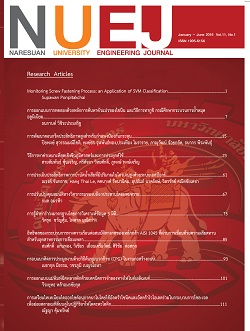การพัฒนาคอนกรีตประสิทธิภาพสูงสำหรับกำแพงป้องกันกระสุน
Main Article Content
Abstract
Article Details
References
รุ่งรวี เฉลิมศรีภิญโญรัช และกองบรรณาธิการโรงเรียนนักข่าวชายแดนใต้. 2555. ถอดความคิดขบวนการเอกราช ปาตานี. ค้นเมื่อ 17 กุมภาพันธ์ 2556, โรงเรียนนักข่าวชายแดนใต้ ศูนย์เฝ้าระวัง
สถานการณ์ภาคใต้ เว็บไซต์: http://www.deepsouthwatch.org/dsj/3676
Hui Yang, Hengwen Song and Shi Zhang, Experimental investigation of the behavior of aramid fiber reinforced polymer confined concrete subjected to high strain-rate compression, Construction and Building Materials, 95 (2015) 143-151.
M.G. Alberti, A. Enfedaque and J.C. Gálvez, Comparison between polyolefin fibre reinforced vibrated conventional concrete and self-compacting concrete, Construction and Building Materials, 85 (2015) 182-194.
Halit Cenan Mertol, Eray Baran and Hussain Jibril Belloa, Flexural behavior of lightly and heavily reinforced steel fiber concrete beams, Construction and Building Materials, 98 (2015) 185-193.
Ziaaddin Zamanzadeh, Lúcio Lourenço and Joaquim Barros, Recycled steel fibre reinforced concrete failing in bending and in shear, Construction and Building Materials, 85 (2015) 195-207.
N. Banthia, M. Sappakittipakorn, Toughness enhancement in steel fiber reinforced concrete through fiber hybridization, Cement and Concrete Research, 37 (2007) 1366–1372.
S.T. Tassew, A.S. Lubell, Mechanical properties of glass fiber reinforced ceramic concrete, Construction and Building Materials, 51 (2014) 215–224.
P. Sukontasukkul, S. Jamnam, K. Rodsin and N. Banthia, Use of rubberized concrete as a cushion layer in bulletproof fiber reinforced concrete panels, Construction and Building Materials, 41 (2013) 801–811.
Ballistic Resistance of Body Armor NIJ Standard-0101.06, National Institute of Justice, U.S. Department of Justice Office of Justice Programs, July 2008.
Standard Specification for Fiber-Reinforced Concrete and Shotcrete, ASTM C 1116-91, ASTM, West Conshohocken, Pa., 1991.
Standard Specification for Steel Fibers for Fiber-Reinforced Concrete, ASTM A820 / A820M - 11, ASTM, West Conshohocken, Pa., 1991.,
Standard Specification for Concrete Aggregates, ASTM C33/ C33M-13, ASTM, West Conshohocken, Pa., 1991.
N. Flores Medina, G. Barluenga and F. Hernández-Olivares, Enhancement of durability of concrete composites containing natural pozzolans blended cement through the use of Polypropylene fibers, Composites: Part B 61 (2014) 214–221.
Roohollah Bagherzadeh, Hamid Reza Pakravan, Abdol-Hossein Sadeghi, Masoud Latifi and Ali Akbar Merati, An investigation on adding polypropylene fibers to reinforce lightweight cement composites (LWC), Journal of Engineered Fibers and Fabrics, 7 (2012) 13-21.
G. Ferro, J.M. Tulliani, P. Jagdale and L. Restuccia, New concepts for next generation of high performance concretes, Procedia Materials Science 3 (2014) 1760–1766.


